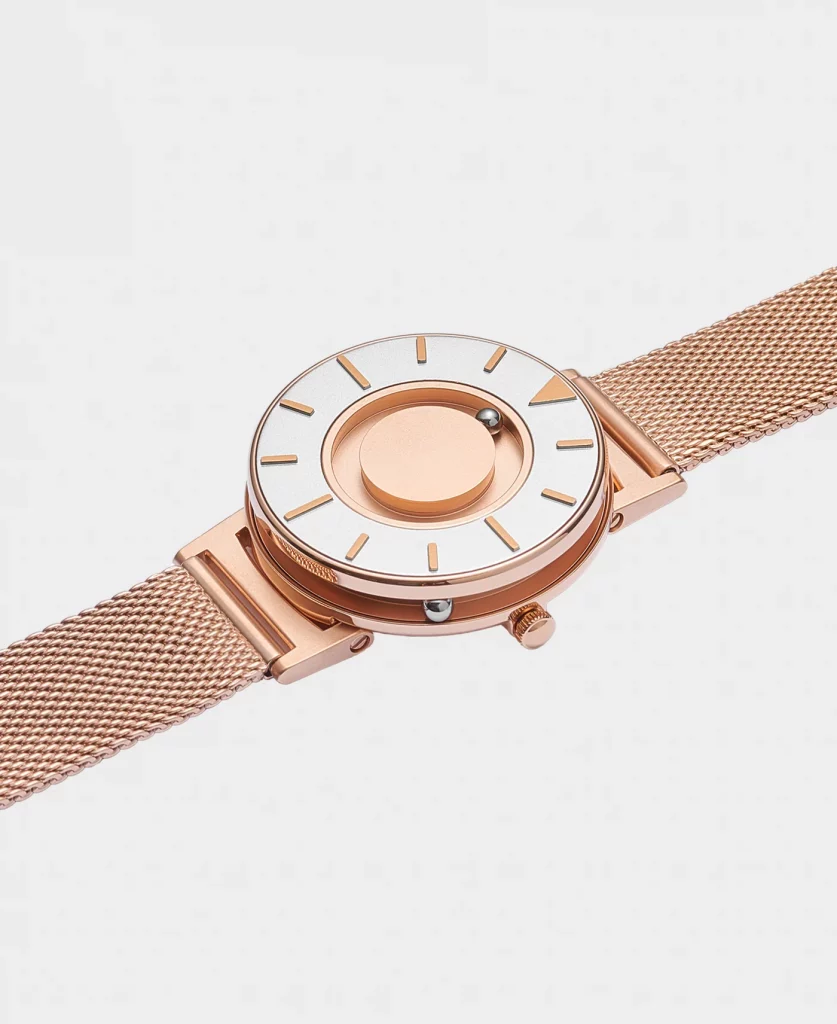The Bradley Timepieces by Eone allow people to tell time entirely by touch. These tactile watches provide a silent alternative to talking watches for people who are blind or visually impaired.
The watch face features raised hour markers, most of them line segments. The markers for 3, 6, and 9 are slightly longer lines, while the 12 marker is a triangle. Two magnetically guided ball bearings represent the current hour and minute; one ball bearing travels along the outside of the watch face to tell the hour, and another circles the center of the watch face to tell the minute. Users tell the time by feeling for the two ball bearings.
Eone offers these watches in various styles, sizes, and colors.

Feature 1: Functionality is completely touch-based.
Because the Bradley watches enable users to tell time entirely by touch, this product offers utility to people who are blind or visually impaired. While talking watches provide this utility as well, there may be certain situations where a person would prefer to tell the time quietly—such as when in class or at the movie theater. Some people may simply prefer a tactile watch to a talking watch in general.
The concept of tactile watches is not entirely new. The Eone website claims that many existing tactile watches are fragile, though I have no way of verifying this claim. However, through my research, I’ve found that most other tactile watches use Braille for the hour markers. According to the National Federation of the Blind, about one in 10 people who are blind can read Braille. So the Bradley watch’s hour markers may be more approachable for those who do not read Braille.
A TikTok reviewer shared another (perhaps unintended) benefit of the watch’s design: the ball bearings can be used as a fidget. Users can play with the ball bearing and it will magnetically snap back into place. This provides utility to people who use tactile stimulation to self-soothe, including some people with ADHD, autism, and anxiety.
I do wonder how usable this product is for people with limited fine motor skills and finger arthritis, as the watch appears to require some level of dexterity to use effectively.
Feature 2: Design shows attention to style.
This product was designed specifically for people with visual impairments. However, unlike some assistive technologies, the Eone watches appear to consider the aesthetic desires of its users, offering desirability.
The watches are sleek and elegant-looking, come in various band sizes and colors, and feature various watch face designs. Eone also incorporates popular fashion trends— such as minimalism, rose gold, and mesh bands—in their designs. These features help make the product more desirable. They may help satisfy the emotional needs of the user by enabling one’s personal style expression and making the experience of using assistive technology feel less othering.
Functional solutions model
This product is an excellent example of the functional solutions model, which emphasizes innovative solutions to help people “overcome” the physical limitations of disabilities. The Bradley watch is a direct solution to, in the words of its designers, the following problem: “to tell time, people who are blind have had to choose between intrusive talking watches, or fragile tactile watches. There were hardly elegant, quality alternatives.”
Social model
The Bradley watch partially aligns with the social model of disability, which argues that the notion of ‘disability’ is created by society and emphasizes elimination of social barriers. The designers’ attention to visual appeal helps counteract the social barriers to using assistive technology.
However, the product does fall short of addressing larger systems of ableism and inaccessibility. The onus is still on the individual to hear about, purchase, and learn how to use this product. The price of the watch, ranging from $260 to $375, is another barrier to access.
Under the social model, the oppressive system of ableism cannot be solved by a single company or a single product. In a less ableist world, maybe talking watches would be considered more socially acceptable. Or maybe society would less closely and unforgivingly follow timed schedules, lessening the need to know the exact time.
But we’re not there yet! As we build toward this non-ableist future, functional solutions like the Bradley Watch can help make living in our current, still-ableist world a bit easier.
